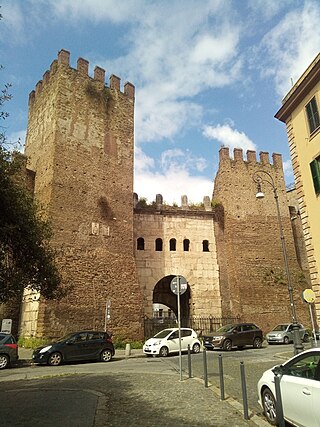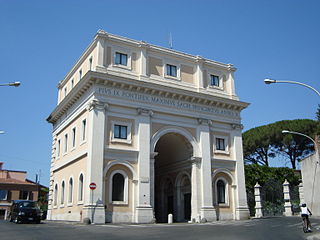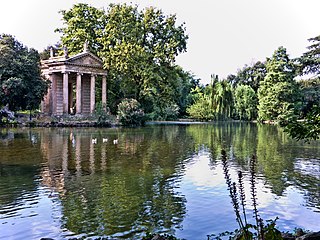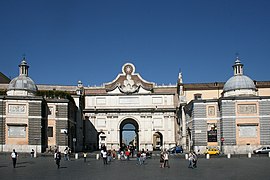History
The previous name was Porta Flaminia, because the consular Via Flaminia passed, as it passes even now, through it (in ancient times, Via Flaminia started at the Porta Fontinalis, close to the current Vittoriano). In the 10th century the gate was named Porta San Valentino, due to the basilica and the catacomb with the same name, rising at the beginning of Viale Pilsudski.
Porta del Popolo is a gate of the Aurelian Walls in Rome (Italy). The current Porta del Popolo was built by Pope Sixtus IV for the Jubilee Year 1475 on the site of an ancient Roman gate which, at that time, was partially buried.
The origin of the present name of the gate, as well as of the piazza that it overlooks, is not clear: it has been supposed that it could derive from the many poplars (Latin: populus) covering the area, but it is more likely that the toponym is connected with the origins of the Basilica of Santa Maria del Popolo (Saint Mary of the People), erected in 1099 by Pope Paschal II thanks to a more or less voluntary subscription of the Roman people.
Considering the importance of the Via Flaminia, Porta del Popolo had, since the beginning of its existence, a prevalent role of sorting of the urban traffic rather than a defensive use. This brought to a never confirmed conjecture that the gate was formerly built with two archways (as well as two cylindrical side towers) and that only during the Middle Ages, as a consequence of the decrease of traffic due to the demographic fall, it was reduced into a single archway. At the age of Sixtus IV, the gate was half-buried and victim of a centuries-old negligence, damaged by time and medieval sieges; a shallow restoration was limited to a partial reinforcement of the structure.
The gate rises still today about a metre and half above the ancient ground level. The debris carried by the river during its desultory floods and the slow but continuous flaking of the Pincian Hill had lifted the surrounding ground, so that the elevation of the whole gate could no longer be procrastinated. This need had already been felt during the restoration carried out in the 5th century by emperor Honorius, but the intervention was not carried out.
The present aspect is the result of a rebuilding carried out in the 16th century, when the gate had again gained a great importance for the urban traffic coming from north. The outer façade was commissioned by Pope Pius IV to Michelangelo, who in turn assigned the task to Nanni di Baccio Bigio: he erected the gate between 1562 and 1565, taking inspiration from the Arch of Titus. The works on the facade were still designed by Michelangelo and the works directed by Jacopo Barozzi da Vignola. The four columns of the façade come from the former St. Peter's Basilica and they frame the single, great archway, overlooked by the stone commemorating the restoration and by the papal coat of arms sustained by two cornucopias; the former circular towers were replaced with two powerful square watchtowers and the whole building was garnished with elegant battlements. In 1638, two statues of St. Peter and St. Paul, sculpted by Francesco Mochi, were inserted between the two pairs of columns: the statues had been rejected by the Basilica of Saint Paul Outside the Walls and given back to the sculptor without payment.
The inscription on the central stone, remembering the restoration carried out by Pius IV, says:
PIVS IIII PONT MAX
PORTAM IN HANC AMPLI
TVDINEM EXTVLIT
VIAM FLAMINIAM
STRAVIT ANNO III
The inner façade was designed by Gian Lorenzo Bernini for Pope Alexander VII and it was released on the occasion of the arrival in Rome of the abdicant queen Christina of Sweden, on December 23, 1655: the occurrence is commemorated by the inscription carved on the attic of the inner façade together with the coats of arm of the Pope's family (the six-pieces mount under the eight-rays star, the emblem of the House of Chigi.
FELICI FAVSTOQ(ue) INGRESSVI
ANNO DOM MDCLV
The positioning of the inscription - on the inner façade instead of the outer one, where it would have been visible while accessing the town - and the quite short text itself, are nonetheless singular; Cesare D'Onofrio deduces that probably the Pope would hold off the intrusiveness and the lively personality of the newly converted former queen, together with all the relevant diplomatic involvements. The visit was nonetheless a memorable event for Roman people, both for the profusion of pomp and splendor and for the annoyance of merchants and peddlers, which were forced to suspend for some days their activities, in order to allow the cleaning and to maintain the decency all along the itinerary of the cortège from Porta del Popolo to St. Peter's Basilica. [1]
Other spectacular cortèges had already passed through the gate: the most impressive was the one of the French army of Charles VIII, which on December 31, 1494, paraded for six hours, giving am uncommon demonstration of military power; but also che processions of the cardinals, gathering into consistory with the Pope in the lead, aroused the enthusiastic and respectful admiration of the people.
Due to the increase of the urban traffic, in 1887 the two lateral archways were opened, after the demolition, in 1879, of the towers flanking the gate; the works costed 300.000 lire). On that occasion, some remains of the ancient structure of the age of Aurelian and of the cylindric towers were discovered: these proved to be very important for the historic recreation of the gate. The works were commemorated with two stones on the outer façade, to the sides of the façade of Pius IV; the inscription on the left is about the first intervention:
ANNO MDCCCLXXIX
RESTITVTAE LIBERTATIS X
TVRRIBVS VTRINQVE DELETIS
FRONS PRODVCTA INSTAVRATA
The one on the right is about the second intervention:
VRBE ITALIAE VINDICATA
INCOLIS FELICITER AVCTIS
GEMINOS FORNICES CONDIDIT
Close to the gate, one of the "duty stones" placed in 175 AD was discovered. Similar stones were discovered in different times nearby other important city gates (the Porta Salaria and the Porta Asinaria); they marked a kind of administrative border, where the "customs offices" rose. These offices formerly collected the duties on the incoming and outcoming goods, but during the Middle Ages were also assigned to the collection of the toll for the transit through the gates, some of which belonged to rich lairds or contractors. The first statements of this institution, that was in effect at least until the beginning of the 15th century, [2] date back to the 5th century. In the 9th century (when the Popes, clashing with the Municipality of Rome, held the administrative control on the duties of almost all the gates), Pope Sergius II granted the proceeds of the toll of the Porta Flaminia to the cloister of San Silvestro in Capite.

GiacomoBarozzida Vignola, often simply called Vignola, was one of the great Italian architects of 16th century Mannerism. His two great masterpieces are the Villa Farnese at Caprarola and the Jesuits' Church of the Gesù in Rome. The three architects who spread the Italian Renaissance style throughout Western Europe are Vignola, Serlio and Palladio. He is often considered the most important architect in Rome in the Mannerist era.

The Aurelian Walls are a line of city walls built between 271 AD and 275 AD in Rome, Italy, during the reign of the Roman Emperor Aurelian. They superseded the earlier Servian Wall built during the 4th century BC.

Borgo is the 14th rione of Rome, Italy. It is identified by the initials R. XIV and is included within Municipio I.

Campo Marzio[ˈkãm.po ˈmar.t͡sjo] is the 4th rione of Rome, identified by the initials R. IV. It belongs to the Municipio I and covers a smaller section of the area of the ancient Campus Martius. The logo of this rione is a silver crescent on a blue background.

The Parish Basilica of Santa Maria del Popolo is a titular church and a minor basilica in Rome run by the Augustinian order. It stands on the north side of Piazza del Popolo, one of the most famous squares in the city. The church is hemmed in between the Pincian Hill and Porta del Popolo, one of the gates in the Aurelian Wall as well as the starting point of Via Flaminia, the most important route from the north. Its location made the basilica the first church for the majority of travellers entering the city. The church contains works by several famous artists, such as Raphael, Gian Lorenzo Bernini, Caravaggio, Alessandro Algardi, Pinturicchio, Andrea Bregno, Guillaume de Marcillat and Donato Bramante.

Piazza del Popolo is a large urban square in Rome. The name in modern Italian literally means "People's Square", but historically it derives from the poplars after which the church of Santa Maria del Popolo, in the northeast corner of the piazza, takes its name.

Giuseppe Valadier was an Italian architect and designer, urban planner and archaeologist and a chief exponent of Neoclassicism in Italy.

Santa Maria dei Miracoli and Santa Maria di Montesanto are two churches in Rome.

The Porta San Sebastiano is the largest and one of the best-preserved gates passing through the Aurelian Walls in Rome (Italy).

Porta Pia was one of the northern gates in the Aurelian Walls of Rome, Italy. One of Pope Pius IV's civic improvements to the city, it is named after him. Situated at the end of a new street, the Via Pia, it was designed by Michelangelo to replace the Porta Nomentana situated several hundred meters southwards, which was closed up at the same time. Construction began in 1561 and ended in 1565, after the artist's death. A 1561 bronze commemorative medal by Gian Federico Bonzagna shows an early plan by Michelangelo, very different from his final design. The façade on the outside of the city was completed in 1869 under the Neo-Classicist design by Virginio Vespignani.

The Via del Corso is a main street in the historical centre of Rome. It is straight in an area otherwise characterized by narrow meandering alleys and small piazzas. Considered a wide street in ancient times, the Corso is approximately 10 metres wide, and it only has room for two lanes of traffic and two narrow sidewalks. The northern portion of the street is a pedestrian area. The length of the street is roughly 1.5 kilometres.

Porta Tiburtina or Porta San Lorenzo is a gate in the Aurelian Walls of Rome, Italy, through which the Via Tiburtina exits the city.

Porta San Pancrazio is one of the southern gates of the Aurelian walls in Rome, Italy.

Porta Settimiana is one of the gates of the Aurelian walls in Rome, Italy). It rises at the northern vertex of the rough triangle traced by the town walls, built by Emperor Aurelian in the 3rd century, in the area of Trastevere an up through the Janiculum.

The Porta Nomentana was one of the gates in the Aurelian Walls of Rome, Italy. It is located along viale del Policlinico, around 70 m east of Porta Pia. It is now blocked and merely a boundary wall for the British Embassy.

The Tridente is the complex of roads formed by three straight streets of Rome (Italy), departing from Piazza del Popolo and diverging southward, taking the shape of a trident.

The Janiculum walls are a stretch of defensive walls erected in 1643 by Pope Urban VIII as a completion of the Leonine wall and for a better protection of the area of Rome rising on the right bank of the Tiber.

Porta Angelica was a gate of the Leonine Wall in Rome (Italy).

Pinciano is the 3rd quartiere of Rome (Italy), identified by the initials Q. III. The name derives from the Pincian Hill. It belongs to the Municipio II.






















